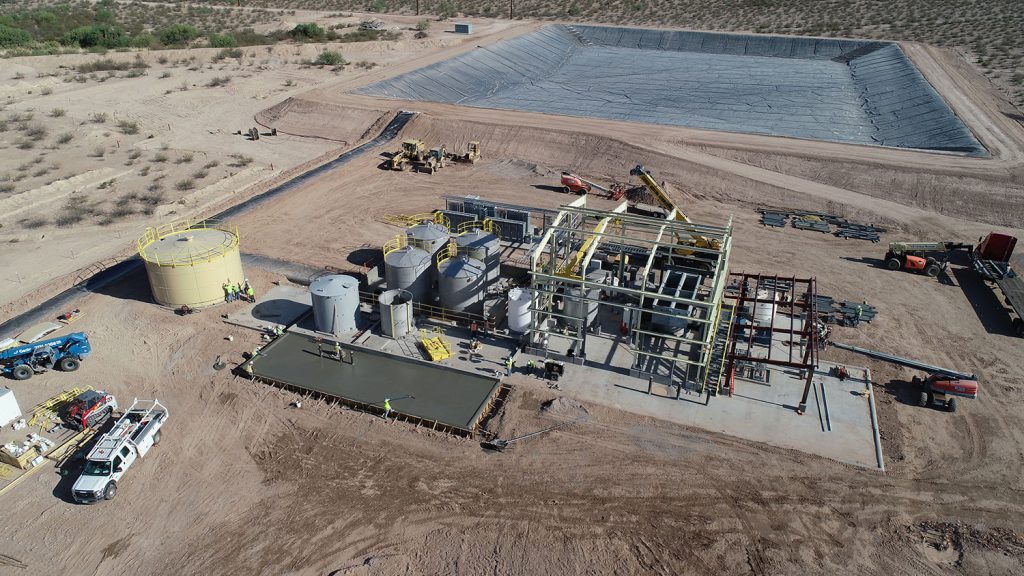
Florence, about halfway between Phoenix and Tucson, is being developed in two phases. In the first phase, a C$25 million production test facility was built, including 24 injection, recovery and monitoring wells and an SX/EW plant, which commenced operation in December 2018.
Operating the test facility over 18 months, the company says, “successfully demonstrated the ability to produce high-quality copper cathode … and confirmed the project economics.” The first harvest of 3,700 lb. of copper cathode (32 sheets x 117 pounds), was completed in August 2019, and the cathode assayed at higher than 99.9% copper.
BMO’s Cartier has a price target on the company of C$2.75 per share and an ‘outperform’ rating
Phase 2 transitions the project to commercial production, and involves an expanded wellfield and SX/EW plant that is slated to produce an average of 85 million lb. of copper a year over 20 years at a cost of $1.13 per lb. copper over the life of the mine.
Initial capex for phase two is $227 million.
Florence Copper has measured and indicated resources of 429 short tons grading 0.33% copper for 2.8 billion lb. of copper and another 63 million tons grading 0.24% copper for 300 million lb. of contained copper.
Taseko acquired the project in November 2014 and the board approved construction of the first phase of the project in September 2017. A potential copper porphyry system was first identified at Florence in the early 1960s.
Less than a week after news of the court ruling was announced, Taseko reported that it has extended its copper price protection strategy by purchasing put options covering 41 million lb. of copper at a strike price of $3.75 per lb. for the second half of 2021. Taseko said the price protection for the next nine months “should secure a minimum operating margin of approximately C$165 million for 2021.”
Stuart McDonald, Taseko’s president, stated in a news release on March 29 that “with the uncertainty in the world today around the impacts of Covid-19, and ongoing volatility in metal markets caused by a number of global economic and political issues, we felt that it was prudent to extend our price protection strategy.”
McDonald noted that “protecting a significant operating margin” this year enables Taseko to advance not only the Florence project but also environmental assessment work on its Yellowhead project.
“This approach to managing copper price volatility does not cap our cash flow should copper prices continue to rise, as many of the world’s largest banks and trading entities are indicating could occur.”
Rene Cartier, who covers Taseko for BMO Capital Markets, described the copper hedging strategy as “positive” and said it “locks in a portion of cash flows.” He added that the copper put options “offer a floor price well above our current estimated copper pricing levels.”
“We see the extension as particularly prudent as it covers a period where Florence should be under construction,” he wrote in a research note to clients. “That said, the importance of receiving the Underground Injection Control permit in a timely manner remains a near-term catalyst.”
Cartier also noted that the market is attributing “very little to no value” for the company’s Yellowhead project.
Yellowhead, 150 km northeast of Kamloops in B.C., is a planned 90,000 tonne per day open pit copper mine with a 25-year mine life. Based on a technical report released in January 2020, Yellowhead would produce more than 4.4 billion lb. of copper, 440,000 oz. of gold and 19 million oz. of silver. Total pre-production capex has been estimated at $1.3 billion.
Yellowhead has measured and indicated resources of 1.29 billion tonnes grading 0.25% copper, 0.028 gram gold per tonne and 1.2 grams silver per tonne and another 109 million inferred tonnes grading 0.24% copper, 0.026 gram gold and 1.2 grams silver.
Last year Taseko’s Gibraltar mine in B.C., the second-largest open-pit copper mine in Canada, produced 123 million lb. of copper and the company expects the mine will produce about 125 million lb. of copper.
With the addition of Florence, the company said last month, Taseko’s attributable annual copper production will grow by 85% to about 185 million lb. copper.
At the end of 2020, Taseko had a cash balance of C$85.1 million and a bond refinancing in February 2021 provided additional net cash proceeds of C$167 million.
BMO’s Cartier has a price target on the company of C$2.75 per share and an ‘outperform’ rating.
Over the last year the company has traded in a range of 34.5¢ and C$2.63 per share and at presstime in Toronto was trading at C$2.14 per share. The company has about 283 million common shares outstanding for a market cap of about C$606 million.
(This article first appeared in The Northern Miner)




